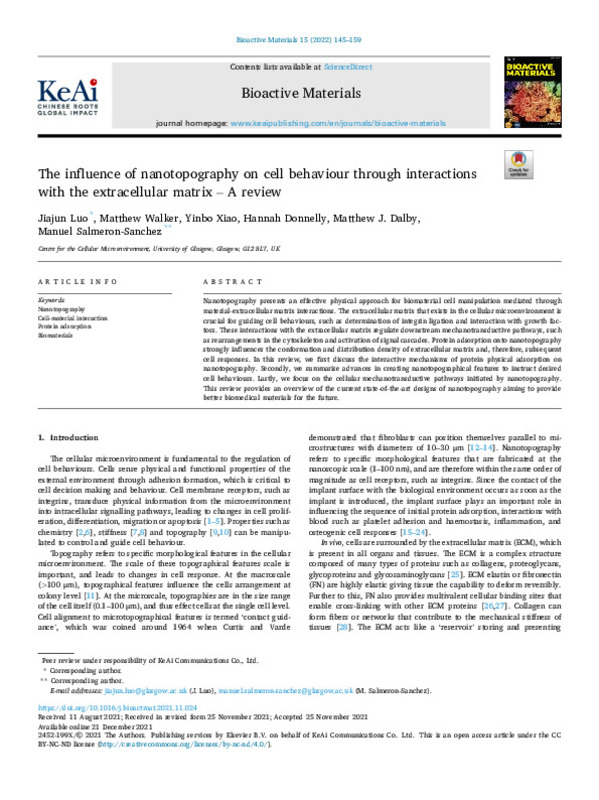JavaScript is disabled for your browser. Some features of this site may not work without it.
Buscar en RiuNet
Listar
Mi cuenta
Estadísticas
Ayuda RiuNet
Admin. UPV
The influence of nanotopography on cell behaviour through interactions with the extracellular matrix - A review
Mostrar el registro sencillo del ítem
Ficheros en el ítem
| dc.contributor.author | Luo, Jiajun
|
es_ES |
| dc.contributor.author | Walker, Matthew
|
es_ES |
| dc.contributor.author | Xiao, Yinbo
|
es_ES |
| dc.contributor.author | Donnelly, Hannah
|
es_ES |
| dc.contributor.author | Dalby, Matthew J.
|
es_ES |
| dc.contributor.author | Salmerón Sánchez, Manuel
|
es_ES |
| dc.date.accessioned | 2022-10-13T18:07:03Z | |
| dc.date.available | 2022-10-13T18:07:03Z | |
| dc.date.issued | 2022-09 | es_ES |
| dc.identifier.uri | http://hdl.handle.net/10251/187681 | |
| dc.description.abstract | [EN] Nanotopography presents an effective physical approach for biomaterial cell manipulation mediated through material-extracellular matrix interactions. The extracellular matrix that exists in the cellular microenvironment is crucial for guiding cell behaviours, such as determination of integrin ligation and interaction with growth factors. These interactions with the extracellular matrix regulate downstream mechanotransductive pathways, such as rearrangements in the cytoskeleton and activation of signal cascades. Protein adsorption onto nanotopography strongly influences the conformation and distribution density of extracellular matrix and, therefore, subsequent cell responses. In this review, we first discuss the interactive mechanisms of protein physical adsorption on nanotopography. Secondly, we summarise advances in creating nanotopographical features to instruct desired cell behaviours. Lastly, we focus on the cellular mechanotransductive pathways initiated by nanotopography. This review provides an overview of the current state-of-the-art designs of nanotopography aiming to provide better biomedical materials for the future. | es_ES |
| dc.description.sponsorship | We acknowledge support from the Leverhulme Trust through gran t RPG-2019-252 and the Engineering and Physical Sciences Research Council (EPSRC) grant EP/P001114/1. | es_ES |
| dc.language | Inglés | es_ES |
| dc.publisher | Ke Ai Publishing Communications Ltd. | es_ES |
| dc.relation.ispartof | Bioactive materials | es_ES |
| dc.rights | Reconocimiento - No comercial - Sin obra derivada (by-nc-nd) | es_ES |
| dc.subject | Nanotopography | es_ES |
| dc.subject | Cell-material interaction | es_ES |
| dc.subject | Protein adsorption | es_ES |
| dc.subject | Biomaterials | es_ES |
| dc.subject.classification | FISICA APLICADA | es_ES |
| dc.title | The influence of nanotopography on cell behaviour through interactions with the extracellular matrix - A review | es_ES |
| dc.type | Artículo | es_ES |
| dc.identifier.doi | 10.1016/j.bioactmat.2021.11.024 | es_ES |
| dc.relation.projectID | info:eu-repo/grantAgreement/Leverhulme Trust//RPG-2019-252/ | es_ES |
| dc.relation.projectID | info:eu-repo/grantAgreement/EPSRC//EP%2FP001114%2F1/ | es_ES |
| dc.rights.accessRights | Abierto | es_ES |
| dc.contributor.affiliation | Universitat Politècnica de València. Departamento de Física Aplicada - Departament de Física Aplicada | es_ES |
| dc.description.bibliographicCitation | Luo, J.; Walker, M.; Xiao, Y.; Donnelly, H.; Dalby, MJ.; Salmerón Sánchez, M. (2022). The influence of nanotopography on cell behaviour through interactions with the extracellular matrix - A review. Bioactive materials. 15:145-159. https://doi.org/10.1016/j.bioactmat.2021.11.024 | es_ES |
| dc.description.accrualMethod | S | es_ES |
| dc.relation.publisherversion | https://doi.org/10.1016/j.bioactmat.2021.11.024 | es_ES |
| dc.description.upvformatpinicio | 145 | es_ES |
| dc.description.upvformatpfin | 159 | es_ES |
| dc.type.version | info:eu-repo/semantics/publishedVersion | es_ES |
| dc.description.volume | 15 | es_ES |
| dc.identifier.eissn | 2452-199X | es_ES |
| dc.identifier.pmid | 35386337 | es_ES |
| dc.identifier.pmcid | PMC8940943 | es_ES |
| dc.relation.pasarela | S\463063 | es_ES |
| dc.contributor.funder | Leverhulme Trust | es_ES |
| dc.contributor.funder | Engineering and Physical Sciences Research Council, Reino Unido | es_ES |








